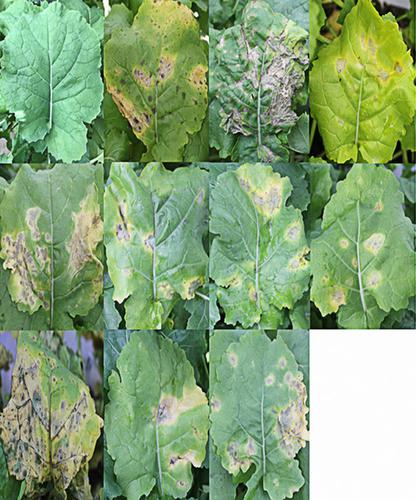当前位置:
X-MOL 学术
›
Plant Pathol.
›
论文详情
Our official English website, www.x-mol.net, welcomes your
feedback! (Note: you will need to create a separate account there.)
Virulence variability across the Alternaria spp. population determines incidence and severity of alternaria leaf spot on rapeseed
Plant Pathology ( IF 2.3 ) Pub Date : 2020-01-02 , DOI: 10.1111/ppa.13135 Hebba F. D. Al‐lami 1, 2, 3 , Ming P. You 1, 2 , Akeel E. Mohammed 1, 2, 4 , Martin J. Barbetti 1, 2
Plant Pathology ( IF 2.3 ) Pub Date : 2020-01-02 , DOI: 10.1111/ppa.13135 Hebba F. D. Al‐lami 1, 2, 3 , Ming P. You 1, 2 , Akeel E. Mohammed 1, 2, 4 , Martin J. Barbetti 1, 2
Affiliation

|
Alternaria leaf spot of Brassicaceae can be a devastating disease caused by several species of Alternaria. Differences in virulence (disease incidence and severity) and consequent defoliation were evaluated for 101 isolates across 10 Alternaria spp. (Alternaria alternata, A. brassicae, A. conjuncta, A. ethzedia, A. eureka, A. hordeicola, A. infectoria, A. japonica, A. metachromatica, and A. tenuissima) on seedlings of Brassica napus ‘Thunder TT’. In terms of disease incidence, severity, and defoliation, all isolates tested were virulent, but levels of isolate virulence varied within and between Alternaria spp. tested. Virulence also varied in relation to the disease assessment parameter used. A. japonica showed the highest virulence and overall mean values of percentage leaf disease incidence (%LDI 97.5), percentage leaf area diseased (%LAD 90.0) and percentage leaf senescence index (%LSI 70.0), followed by A. brassicae with 65.0, 55.0, and 35.0, A. ethzedia with 50.9, 41.8, and 15.9, and A. alternata with 48.4, 41.1, and 14.8, for %LDI, %LAD, and %LSI, respectively. The remaining Alternaria spp. also expressed varying levels of virulence in relation to the particular disease parameter used. These findings highlight the variation in relative levels of virulence, in terms of disease incidence, severity, and defoliation, within and between Alternaria spp. associated with leaf spot on rapeseed and reflect the relative importance of different pathogen populations of Alternaria spp. In particular, the potential of A. japonica and A. ethzedia to be significant pathogens of rapeseed in Australia, along with A. brassicae and A. alternata, is highlighted.
中文翻译:

整个链格孢菌的毒力变异性。人群决定油菜籽中交链孢菌叶斑的发生率和严重程度
十字花科的链格孢菌叶斑病可能是几种链格孢菌造成的破坏性疾病。评价了10个链格孢属(Alternaria spp)中101个分离株的毒力差异(疾病发生率和严重程度)以及随后的落叶。(链格孢,A.甘蓝,A. conjuncta,A. ethzedia,A.尤里卡,A. hordeicola,A. infectoria,A.粳稻,A. metachromatica,和A.极细)上的秧苗甘蓝型油菜“雷电TT”。就疾病发生率,严重程度和脱叶而言,所有测试的分离株均具有毒性,但分离链霉菌属之间和之间的分离株毒力水平各不相同。经过测试。毒力也与使用的疾病评估参数有关。粳稻的毒力和总平均值最高,分别为叶病发生率(%LDI 97.5),叶病百分率(%LAD 90.0)和叶衰老指数(%LSI 70.0),其次是芸苔科,为65.0,%LDI,%LAD和%LSI分别为55.0和35.0,ethzedia分别为50.9、41.8和15.9,交替链霉菌为48.4、41.1和14.8。剩下的链格孢属spp。相对于所使用的特定疾病参数,还表达了不同水平的毒力。这些发现凸显了链格孢菌内部和之间的相对毒力水平的变化,如疾病发生率,严重程度和落叶。与油菜籽上的叶斑相关,反映了链格孢菌不同病原体种群的相对重要性。特别是,潜在的A.粳稻和A. ethzedia是澳大利亚油菜籽显著病原体,随着A.甘蓝和链格孢,高亮显示。
更新日期:2020-01-02
中文翻译:

整个链格孢菌的毒力变异性。人群决定油菜籽中交链孢菌叶斑的发生率和严重程度
十字花科的链格孢菌叶斑病可能是几种链格孢菌造成的破坏性疾病。评价了10个链格孢属(Alternaria spp)中101个分离株的毒力差异(疾病发生率和严重程度)以及随后的落叶。(链格孢,A.甘蓝,A. conjuncta,A. ethzedia,A.尤里卡,A. hordeicola,A. infectoria,A.粳稻,A. metachromatica,和A.极细)上的秧苗甘蓝型油菜“雷电TT”。就疾病发生率,严重程度和脱叶而言,所有测试的分离株均具有毒性,但分离链霉菌属之间和之间的分离株毒力水平各不相同。经过测试。毒力也与使用的疾病评估参数有关。粳稻的毒力和总平均值最高,分别为叶病发生率(%LDI 97.5),叶病百分率(%LAD 90.0)和叶衰老指数(%LSI 70.0),其次是芸苔科,为65.0,%LDI,%LAD和%LSI分别为55.0和35.0,ethzedia分别为50.9、41.8和15.9,交替链霉菌为48.4、41.1和14.8。剩下的链格孢属spp。相对于所使用的特定疾病参数,还表达了不同水平的毒力。这些发现凸显了链格孢菌内部和之间的相对毒力水平的变化,如疾病发生率,严重程度和落叶。与油菜籽上的叶斑相关,反映了链格孢菌不同病原体种群的相对重要性。特别是,潜在的A.粳稻和A. ethzedia是澳大利亚油菜籽显著病原体,随着A.甘蓝和链格孢,高亮显示。











































 京公网安备 11010802027423号
京公网安备 11010802027423号